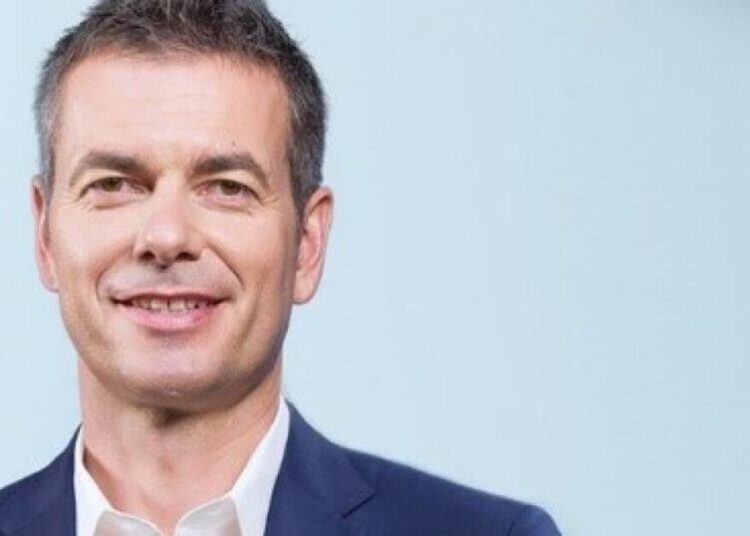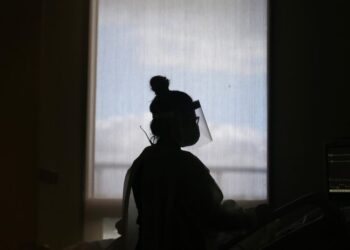The day before Halloween, President Trump landed at Joint Base Andrews after spending nearly a week in Japan and South Korea. He was then whisked to the White House, where he passed out candy to trick-or-treaters. Allies crowed over the president’s stamina: “This man has been nonstop for DAYS!” one wrote online.
A week later, Mr. Trump appeared to doze off during an event in the Oval Office.
With headline-grabbing posts on social media, combative interactions with reporters and speeches full of partisan red meat, Mr. Trump can project round-the-clock energy, virility and physical stamina. Now at the end of his eighth decade, Mr. Trump and the people around him still talk about him as if he is the Energizer Bunny of presidential politics.
The reality is more complicated: Mr. Trump, 79, is the oldest person to be elected to the presidency, and he is aging. To pre-empt any criticism about his age, he often compares himself to President Joseph R. Biden Jr., who at 82 was the oldest person to hold the office, and whose aides took measures to shield his growing frailty from the public, including by tightly managing his appearances.
Mr. Trump has hung a photo of an autopen in a space where Mr. Biden’s portrait would otherwise be, and disparages his predecessor’s physicality often.
“He sleeps all the time — during the day, during the night, on the beach,” Mr. Trump said about Mr. Biden last week, adding: “I’m not a sleeper.”
Mr. Trump remains almost omnipresent in American life. He appears before the news media and takes questions far more often than Mr. Biden did. Foreign leaders, chief executives, donors and others have regular access to Mr. Trump and see him in action.
Still, nearly a year into his second term, Americans see Mr. Trump less than they used to, according to a New York Times analysis of his schedule. Mr. Trump has fewer public events on his schedule and is traveling domestically much less than he did by this point during his first year in office, in 2017, although he is taking more foreign trips.
He also keeps a shorter public schedule than he used to. Most of his public appearances fall between noon and 5 p.m., on average.
And when he is in public, occasionally, his battery shows signs of wear. During an Oval Office event that began around noon on Nov. 6, Mr. Trump sat behind his desk for about 20 minutes as executives standing around him talked about weight-loss drugs.
At one point, Mr. Trump’s eyelids drooped until his eyes were almost closed, and he appeared to doze on and off for several seconds. At another point, he opened his eyes and looked toward a line of journalists watching him. He stood up only after a health company executive who was standing near him fainted and collapsed.
Mr. Trump has prompted additional questions about his health by sharing news about medical procedures he has had, but not details about them. While in Asia, Mr. Trump revealed that he had undergone magnetic resonance imaging at Walter Reed National Military Medical Center in early October.
“I gave you the full results,” Mr. Trump told reporters, mischaracterizing the summary that was released by his physician, which did not say that Mr. Trump had an M.R.I. scan and contained few other details.
“I have no idea what they analyzed,” Mr. Trump told reporters aboard Air Force One recently after he was again asked about his M.R.I. “But whatever they analyzed, they analyzed it well, and they said that I had as good a result as they’ve ever seen.”
Mr. Trump also applies makeup to a bruise on the back of his right hand, adding speculation about a medical condition that his physician and aides say is caused by taking aspirin and shaking so many hands. In September, the bruising on his hand, coupled with swollen ankles, caused observers on the internet to speculate wildly about his health.
In response to a list of questions about Mr. Trump’s health, including about the results of his M.R.I. and whether or not he was falling asleep in the Oval Office, Karoline Leavitt, the White House press secretary, praised the president’s energy and pointed to Mr. Biden.
“Unlike the Biden White House, who covered up Joe Biden’s cognitive decline and hid him from the press, President Trump and his entire team have been open and transparent about the president’s health, which remains exceptional,” Ms. Leavitt said in a statement.
Later Starts, Fewer Events
For years, concerns and questions about Mr. Trump’s health have often been met with obfuscation or minimal explanation from the people around him. Mr. Trump’s physicians have not taken questions from reporters in years, including when he was seriously ill with Covid in 2020. There were no medical briefings held after an assassination attempt against him in Butler, Pa., last summer.
Many of the facts that concerned critics about Mr. Trump’s physical health during his first term are present now. He does not get regular exercise, in part because he has a long-held theory that people are born with a finite amount of energy and that vigorous activity can deplete that reserve, like a battery. He enjoys red meat and is known to eat McDonald’s by the sackful.
According to his physician, however, he has lost weight. In 2020, Mr. Trump tipped the scales at 244 pounds, a weight formally deemed obese for his 6-foot-3 frame. This year, Mr. Trump’s physician, Dr. Sean P. Barbabella, said in a summary of the president’s health that he weighed 224 pounds.
Mr. Trump frequently muses about the effectiveness of weight-loss drugs like Ozempic — he refers to them as the “fat drug” — and talks about people he knows who have taken the medications, but his physician has not said if he takes one of the drugs himself.
“President Trump exhibits excellent cognitive and physical health and is fully fit to execute the duties of the commander in chief and head of state,” Dr. Barbabella wrote in April.
Still, in his second term, Mr. Trump’s schedule shows some significant changes.
According to a Times analysis of the official presidential schedules in a database maintained by Roll Call, Mr. Trump’s first official event starts later in the day. In 2017, the first year of his first term, Mr. Trump’s scheduled events started at 10:31 a.m. on average. By contrast, Mr. Trump in his second term has started scheduled events in the afternoon on average, at 12:08 p.m. His events end on average at around the same time as they did during the first year of his first term, shortly after 5 p.m.
The number of Mr. Trump’s total official appearances has decreased by 39 percent. In 2017, Mr. Trump held 1,688 official events between Jan. 20 and Nov. 25 of that year. For that same time period this year, Mr. Trump has appeared in 1,029 official events.
Mr. Trump still regularly comes down to the Oval Office after 11 a.m., according to a person familiar with his schedule. This routine is a holdover from his first term: After he complained about being overscheduled in the mornings, Mr. Trump kept so-called executive time hours in the White House residence before he headed downstairs for work.
Mr. Trump has kept up frequent international travel, often with tight turnarounds, including a one-day trip to Israel and Egypt in October. Mr. Trump has logged more international travel than he did the first year of his first term; he took four international trips that year and has taken eight so far this year.
Mr. Trump holds frequent Oval Office events, posts regularly on social media, and is often at his golf clubs on the weekend, though most of what he does there is shielded from the public.
Mr. Trump has long rambled in his speeches; during his 2024 campaign and in his second term, the meandering has often been noticeable. He can veer off script to share stories that are sometimes riddled with untruths, such as his false claim that his uncle, John Trump, had taught the domestic terrorist Ted Kaczynski at M.I.T.
“I said, ‘What kind of a student was he, Uncle John, Dr. John Trump?’ He said, ‘What kind of a student?’ And then he said, ‘seriously good.’ He said he’d go around correcting everybody,” Mr. Trump said during a speech in Pennsylvania in July. “But it didn’t work out too well for him, didn’t work out too well, but it’s interesting in life. But I will say this that we have the greatest brains, we have the greatest power and we are going to have more electric.”
Presidents, in general, try to paint the best picture possible of their health. Matthew Dallek, a political historian at George Washington University, said that Mr. Trump was following examples set by his predecessors, including his most recent one.
“The people around him are similar to Biden’s aides,” Mr. Dallek said. “They would talk as if we’re living in a little bit of a fantasy world. Trump, in that way, with the help of his aides and his doctors have created this fiction about his health to hide the hard, cold truth that he is 79 and one of the oldest people to ever occupy the Oval Office.”
No Rulebook for Health Reports
Like any other medical patient — and any other president — what Mr. Trump chooses to reveal to the public about his health is up to him.
With no official template for releasing health information, physicians sometimes rely on summaries of medical tests without going into detail. A physician for Mr. Biden, who faced persistent questions about his health, wrote last year that he had taken an “extremely detailed” neurological exam, but did not say whether the examination contained common tests for assessing cognitive decline or detecting signs of dementia that are often recommended for older adults.
“President Trump’s physician has released two detailed reports following both of his physical examinations as part of his ongoing health maintenance plan; and anyone who watches President Trump in his daily public events can clearly see he is in impressive physical and mental shape, with an unrelenting work ethic,” Ms. Leavitt said in a statement.
Dr. Jeffrey Kuhlman, who served as a White House physician from 2000 to 2013 and wrote a book about presidential health care, said that Mr. Trump’s schedule contrasts with those held by George W. Bush, who was 54 when he took office, and Barack Obama, who was 47. Both built exercise into their daily schedules; Mr. Bush was in the Oval Office by 6:45 a.m. every day, Dr. Kuhlman said, and Mr. Obama would arrive by 10 a.m., though his days often went later, until 7 p.m. or so, when he would meet his family for dinner.
“They show him as effective,” Dr. Kuhlman said of Mr. Trump’s aides, “but every time he’s in the Oval Office, he’s sedentary.”
Dr. Kuhlman added that it is “commendable” that, at his age, Mr. Trump still boards Air Force One using a long flight of stairs, “but you don’t know what he does as soon as he walks in the door.”
With his approval rating falling among voters and more Americans reporting dissatisfaction with the economy, Mr. Trump’s allies have urged him to direct his focus back to domestic affairs. The president’s aides say they expect him to do more travel through the United States ahead of the midterms, but Mr. Trump is also considering a trip to Davos, Switzerland, to attend a conference alongside global leaders and corporate titans in the winter.
There is one thing Mr. Trump is doing more of in his second term: talking about the afterlife. He has brought up heaven — and the question of whether he would get in — half a dozen times since taking office for the second time.
“There has to be some kind of a report card up there someplace,” Mr. Trump said during an interview with Fox News in August, adding: “It’s sort of a beautiful thing.”
While he was ruminating, his trademark competitiveness kicked in, and he turned back to Mr. Biden.
“Look, religion was the backbone of our country; it’s much less so now, but it’s getting much stronger under me,” Mr. Trump said. “It was terrible under Biden. I was so amazed, you know, I won the evangelicals like by 88 percent.”
Katie Rogers is a White House correspondent for The Times, reporting on President Trump.
The post Shorter Days, Signs of Fatigue: Trump Faces Realities of Aging in Office appeared first on New York Times.




